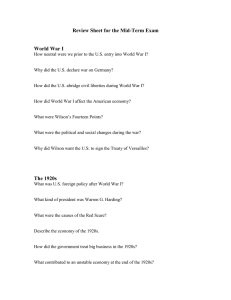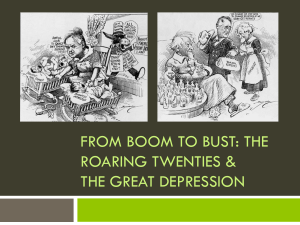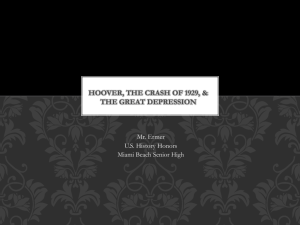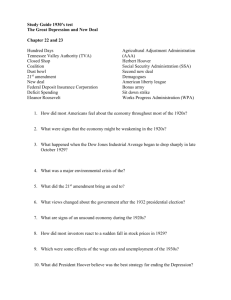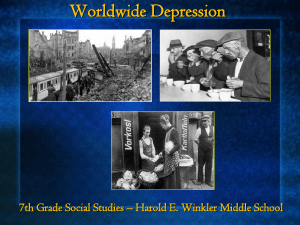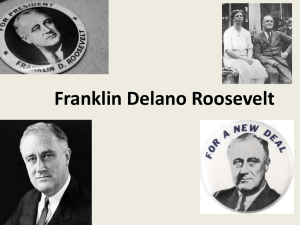FROM BOOM TO BUST: THE ROARING TWENTIES & THE GREAT DEPRESSION
advertisement
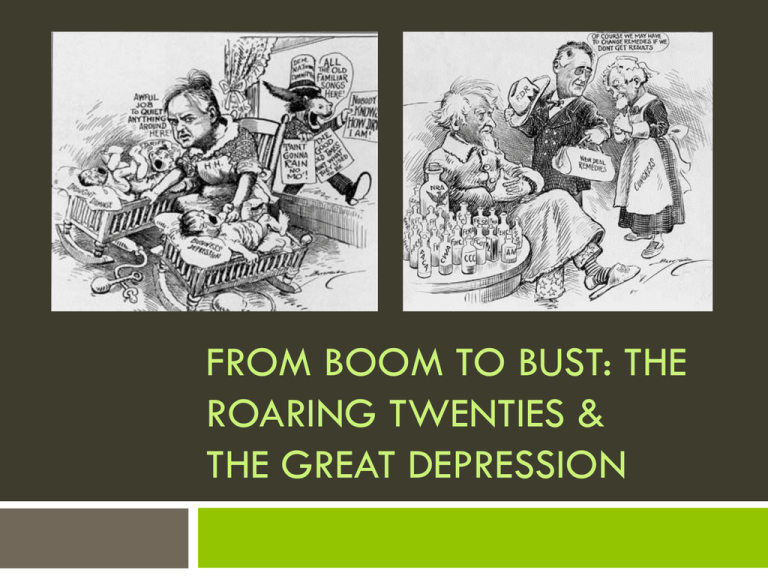
FROM BOOM TO BUST: THE ROARING TWENTIES & THE GREAT DEPRESSION Changing Culture in the USA Dynamic Changes in American Culture During the 1920s and 1930s… Entertainment and Mass Media Radio broadcasts began for the first time during the 1920s – at KDKA in Pittsburgh, PA. By the 1930s, figures like Franklin Delano Roosevelt were using the radio to convey important messages. FDR’s “Fireside Chats” were very influential. Hollywood and the Movies In the 1920s, the movies became American’s favorite form of recreation. It was a way to escape the difficulties of the Depression, too. Hollywood became the center of the film industry during the 1920s, and “talkies” – films with sound – became popular for the first time. Newspapers and Magazines Published daily, weekly, monthly, or quarterly, newspapers and magazines established wide circulations in the 1920s and 1930s. Newspapers and magazines shaped cultural norms and sparked fads! The Scopes Monkey Trial When John Scopes, a substitute science teacher was arrested for teaching Charles Darwin’s Theory of Evolution in 1925 – in violation of Tennessee’s Butler Act – a show trial ensued. It pitted the notorious defense lawyer Clarence Darrow against William Jennings Bryan, and it ended with many Americans in opposition to strict religious doctrines being taught in public schools. Flappers and Female Voters With the passage of the 19th Amendment to the Constitution in 1919, women were allowed to vote in national elections. Flappers – liberated women who challenged gender roles during the 1920s, continued the movement towards women’s liberation during the Roaring Twenties… The Rise of the Ku Klux Klan Really? Yes, really. During the 1920s, membership in the Ku Klux Klan skyrocketed to over five million members. Racists, anti-Semites, antiCatholics, and nativists all found a home in this violent organization. During the 1920s, the Klan marched down Pennsylvania Avenue in Washington D.C. Although most Presidents did not seek out the endorsement of the Ku Klux Klan, many members of the US government were card carrying members, and many more tacitly approved of the organization. Prohibition and Speakeasies Americans were divided over the issue of Prohibition even as it was enacted. Many Americans considered Prohibition of alcohol a wonderful idea – for anyone but them! Indeed, it was never illegal to drink alcohol, only to make it, transport it, or sell it. Those who had it could drink up! By the 1920s, so much organized crime had developed in the United States to satisfy the enormous demand for alcohol, that many supporters of the 18th Amendment had begun to reconsider their views. In 1933, the 21st Amendment was passed, and one of President Franklin Delano Roosevelt’s first acts was to bring back beer! (He was re-elected four (4) times.) Causes of the Great Crash of 1929 What caused the Stock Market Crash of 1929, or “Black Tuesday” to have such an enormous impact on the American Economy? Over Speculation: Buying “On the Margin”, a 1920s Tradition on Wall St. Buying on the margin allowed stockbrokers to use “other people’s money” to purchase stock. This practice allowed investors to make out like bandits during good times, earning up to ten times the profits they might have otherwise. But when the Stock Market bottomed out, innocent Americans lost out! The Over Extension of Credit Expanding credit to consumers was a large part of the expansion of the economy during the 1920s, as well. However, granting credit is only a good plan when people can pay off their debts. After the Stock Market Crash, many Americans were unable to pay their creditors off, prolonging the pain of the Great Depression… The Stock Market Crash of 1929 The most important cause of the Great Depression is the Stock Market Crash of 1929. Not only was the Stock Market Crash an enormous loss for stockbrokers and a shock to business owners, it was also a crippling blow to banks and the holders of savings accounts. You didn’t have to be a stock broker to lose your whole savings in the Stock Market Crash of 1929. Business Failures Lead to Bankruptcy. The vicious cycle of business failure, bankruptcy, and unemployment described to the right was taking place all over American from 1929 until the Depression had set in at it’s worst. Companies could not retain workers, and the economy went into the tank for years. This was capitalism at it’s worst – and people suffered accordingly. Overproduction left many companies with more products than they could sell. Companies were forced to lay off or fire workers. Fired workers don’t make money… they’re unemployed. The Unemployed don’t have any purchasing power. Sales for other companies drop. More companies lay off or fire workers. The Federal Reserve Failed to Act. The Federal Reserve had been created by Woodrow Wilson’s administration, and it’s purpose was to act as a regulating central bank for the United States. By setting interest rates and placing controls on currency, it could regulate the money supply and lending rates and help to manage the nation’s economy. The Federal Reserve failed to prevent the onset of the Great Depression. It did not regulate banks adequately, allowing them to make reckless and uninsured loans to stockbrokers which ruined the economy. Buying on the Margin? Stockbrokers who bought “on the margin” were essentially borrowing money from the bank – from your savings account – in order to invest larger amounts into certain stocks. If they made money, it was easy enough to pay off these short term loans with the profits. When the Stock Market Crash occurred, however, they owed ten times what they had… and stockbrokers couldn’t pay back their debts. Many people were blamed for starting the Great Depression. But savings account holders could justifiably blame stockbrokers – and reckless bankers – for squandering their hard earned money. Bank Failures in the 1920s As word got out that savings accounts were not secure, and that banks were in jeopardy of closing, a run on the banks took place. Account holders withdrew all of their savings, first come, first serve. Banks gave out money to account holders for as long as they could; however, the amount of money held in reserve was a small percentage of investments. When the money ran out, many savings account holders were left empty-handed. Over 9,000 Banks Failed by 1933. Over 9,000 banks failed during the Hoover years. When Franklin Roosevelt came into office in 1933, his first move was to declare a “Bank Holiday” and create new rules for banking in the United States – guaranteeing the deposits of savings account holders on the credit of the federal government. Nevertheless, with so many banks closed, there was no money being invested in the economy – and little hope for a recovery… High Tariffs Strangled World Trade High tariffs were traditionally put in place to protect American made goods – and make them sell better. By placing a tax on European made automobiles, for example, American made cars would cost less and sell better. But when other countries retaliated with high tariffs of their own, Americans lost markets in Europe. The Tariff was as high as 40% on imported goods during the 1920s, making it practically impossible for foreign goods to sell competitively in American markets. Europeans countered with tariffs of their own, and the economy was hurt overall. Impacts of the Great Depression Unemployment and Homelessness The rates of unemployment in the United States were staggering throughout the Great Depression. By 1932, the worst year of the Great Depression, the United States had an unemployment rate close to 25 percent. When jobs became available, enormous lines were created by men anxious to do anything for compensation. Many men left their families in order to become transient workers, going from town to town – hobo style – looking for work. They sent home what they earned. Most of the time, however, these men had a hard time. They were chased out of towns when work was scarce, and harassed by the police. Hoovervilles Poverty, disease, and foul smells permeated the environment in Hoovervilles – so named in order to disparage the President. Hoovervilles were generally on the edge of towns – shanties without heat, plumbing or basic sanitation. Collapse of Banking and Finance Once the bank runs began in the autumn of 1929, a vicious cycle soon emerged. As depositors took everything they could out of the banks, the entire financial system of the United States was crippled. No one had money – and no one was able to lend money. The lack of investment prevented any recovery. With no money in the banks, reviving the economy became exceedingly difficult. There was no way for banks to promote business because they had no money to lend, and no business venture was a sure thing during the 1930s. Decline in Demand for Goods The Vicious Cycle of Poverty, Great Depression Style Behold! The vicious cycle of poverty. When people lose their jobs, they can’t buy things. When people can’t buy things, businesses fire employees. It can keep up for a long, long, time, and when it does, recessions and depressions occur and persist. Farming Failures and Migration During the 1930s, and ecological disaster hit the Great Plains which was every bit as catastrophic to the environment as the Depression had been to the economy. The Dust Bowl, which turned fertile farmland to bedrock in just a few years, forced many families to migrate West, or starve. Parts of Kansas, Oklahoma, Texas, New Mexico, and Colorado were left vacant as Americans moved West to escape certain death. The Dust Bowl – American Migrants FDR and The New Deal Roosevelt’s New Deal Changes the Role of Government in the United States The New Deal Changes the Role of Government in the United States. Franklin Roosevelt had three major goals with the New Deal programs he enacted. First, to provide relief to the poor and unemployed. Secondly, to provide jobs and stimulate the economy. Finally, to prevent future economic collapses by regulating banks and the stock market exchange. FDR Rallied a Fearful Nation, 1933 March 4, 1933, FDR addressed the nation during his first inaugural. “So, first of all, let me assert my firm belief that the only thing we have to fear is fear itself – nameless, unreasoning, unjustified terror which paralyzes needed efforts to convert retreat into advance.” Direct Relief and Employment Works Progress Administration (WPA) – The WPA put thousands of Americans to work on large scale programs like dams, airports, municipal buildings, roads, and bridges. Federal Emergency Relief Administration (FERA) – This organization, which has evolved into FEMA (Federal Emergency Management Administration), gave federal money to the states. The states were able to spend money as they saw fit – to provide aid to those in need. Recovery Programs to Bring the Nation Out of Economic Depression Agricultural Adjustment Act (AAA) – This New Deal Program actually paid farmers NOT TO grow crops. This artificially inflated the price of crops. While this may seem backwards at first, remember this: most Americans were farmers in the 1930s. National Recovery Administration (NRA)- This organization required businesses to keep on as many workers as possible, and to pay them as much as was reasonable. The program was later ruled unconstitutional. Reforms to the Banking Industry The Federal Deposit Insurance Corporation (FDIC) – This program guarantees the bank deposits of investors up to a certain amount. Meaning that if the bank should lose your money, the federal government guarantees that you will be reimbursed! It still exists today. Securities and Exchange Commission (SEC) – This government agency supervised transactions on stock market exchanges, in hopes of preventing the sort of speculation and reckless trading which made the Stock Market collapse October 29, 1929. It still exists today. Labor Unions Gain Strength Labor Unions gained strength during the Great Depression Era. President Franklin Roosevelt was a strong supporter of unions. The fact that so many people were so poor meant that wages dropped considerably, and FDR – along with most labor unions – believed that a minimum wage must be established. Groups like the Congress of Industrial Organization organized effective strikes and the United Auto Workers carried out the first ever Sit-In Strike, in Flint, Michigan. The Social Security Administration The Social Security Act (SSA) is one of the New Deal programs which is still with us today. The program sends out government payments – taken out of worker’s paychecks. The money distributed provides safeguards for unemployed workers, the elderly, the disabled, and dependent children of the poor. The New Deal’s Legacy The government has a responsibility to provide public services. The government has a role to play intervening in the economy (no laissez-faire) The government must promote the general welfare. “When land failed, our ancestors moved on to better land. It was always possible to push back the frontier, but the frontier has now disappeared. Our task involves the making of a better living out of the lands that we have. So, also, security was attained in the earlier days through the interdependence of members of families upon each other and of the families within a small community upon each other. The complexities of great communities and of organized industry make less real these simple means of security. Therefore, we are compelled to employ the active interest of the Nation as a whole through government in order to encourage a greater security for each individual who composes it.” - Franklin Delano Roosevelt
